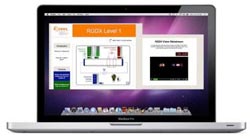Bring a 50,000-degree plasma into your living room

Remote users can operate a plasma experiment with a set of controls, shown on the left side of the screen, and watch the effect on the apparatus at PPPL using the web stream video,<br><br>Credit: A. Dominguez and A. Zwicker<br>
With the rise of online open course platforms such as Khan Academy, MIT OpenCourseWare and iTunes U, it has never been easier to teach yourself everything from American history to semiconductor manufacturing.
These courses enable students to advance at their own pace while accessing the limitless resources available on the internet for supplemental material.
But there's a glaring exception to this cornucopia of courseware: Online physics classes that enable students to interact with a real physical experiment. While excellent online sites like Phet Interactive Simulations have developed virtual labs that simulate laboratory environments, there is no substitute for actual live experiments.
At the U.S. Department of Energy's Princeton Plasma Physics Laboratory (PPPL), we've developed software for an experiment that can be observed and controlled from anywhere in the world.
The user can operate the experiment with a set of controls, shown on the left side of the screen, and watch the effect on the apparatus at PPPL using the web stream video, shown on the right. This “Remote Glow Discharge Experiment (RGDX)” consists of three main components:
A live-streaming video that constantly observes an experimental apparatus housed at PPPL.
A set of online controls.
Information that explains what the user observes and controls, plus more in-depth resources that explore plasma and its uses.
The RGDX consists of a hollow glass tube with air held under vacuum. Supplying a voltage of up to 2000V generates a glow discharge within. The user has control of the pressure inside the tube, the voltage supplied to the plasma and of the strength of an electromagnet surrounding the tube. Users are guided through steps that gradually increase their level of engagement and introduce them to new physical concepts and topics. If the user is interested in the physics behind the voltages, pressures and magnets, further explanations are given for each topic.
Audiences for the RGDX can range from someone simply interested in controlling a physical apparatus from afar, to an undergraduate or graduate student who wants to study phenomena such as instabilities in plasma or the physics behind plasma breakdown voltages. The RGDX can be used as a novel experimental component of either an online or in-class physics course, and the software can be adapted to a wide array of experiments.
Research Contacts:
A. Dominguez, (609) 243-2568, arturod@pppl.gov
A. Zwicker, (609) 243-2150, azwicker@pppl.gov
Abstracts:
JP8.00006 Remote control of a DC discharge experiment
Session JP8: Poster Session IV: Education and Outreach, MHD, Alpha
Heating & Computational Methods
2:00 PM-5:00 PM, Tuesday, November 12, 2013
Room: Plaza ABC
Media Contact
More Information:
http://www.aps.orgAll latest news from the category: Physics and Astronomy
This area deals with the fundamental laws and building blocks of nature and how they interact, the properties and the behavior of matter, and research into space and time and their structures.
innovations-report provides in-depth reports and articles on subjects such as astrophysics, laser technologies, nuclear, quantum, particle and solid-state physics, nanotechnologies, planetary research and findings (Mars, Venus) and developments related to the Hubble Telescope.
Newest articles

Superradiant atoms could push the boundaries of how precisely time can be measured
Superradiant atoms can help us measure time more precisely than ever. In a new study, researchers from the University of Copenhagen present a new method for measuring the time interval,…

Ion thermoelectric conversion devices for near room temperature
The electrode sheet of the thermoelectric device consists of ionic hydrogel, which is sandwiched between the electrodes to form, and the Prussian blue on the electrode undergoes a redox reaction…

Zap Energy achieves 37-million-degree temperatures in a compact device
New publication reports record electron temperatures for a small-scale, sheared-flow-stabilized Z-pinch fusion device. In the nine decades since humans first produced fusion reactions, only a few fusion technologies have demonstrated…





















